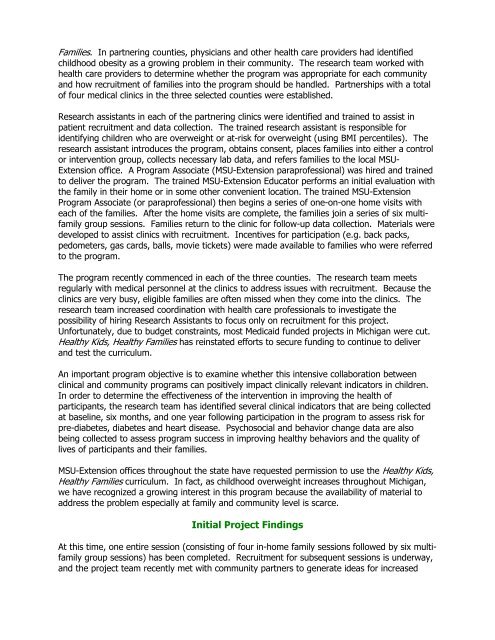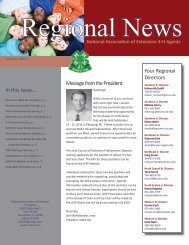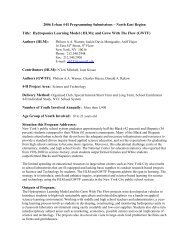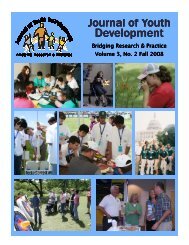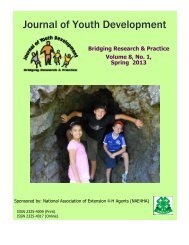Winter 2008 - Vol. 3 No. 3 - National Association of Extension 4-H ...
Winter 2008 - Vol. 3 No. 3 - National Association of Extension 4-H ...
Winter 2008 - Vol. 3 No. 3 - National Association of Extension 4-H ...
- No tags were found...
Create successful ePaper yourself
Turn your PDF publications into a flip-book with our unique Google optimized e-Paper software.
Families. In partnering counties, physicians and other health care providers had identifiedchildhood obesity as a growing problem in their community. The research team worked withhealth care providers to determine whether the program was appropriate for each communityand how recruitment <strong>of</strong> families into the program should be handled. Partnerships with a total<strong>of</strong> four medical clinics in the three selected counties were established.Research assistants in each <strong>of</strong> the partnering clinics were identified and trained to assist inpatient recruitment and data collection. The trained research assistant is responsible foridentifying children who are overweight or at-risk for overweight (using BMI percentiles). Theresearch assistant introduces the program, obtains consent, places families into either a controlor intervention group, collects necessary lab data, and refers families to the local MSU-<strong>Extension</strong> <strong>of</strong>fice. A Program Associate (MSU-<strong>Extension</strong> parapr<strong>of</strong>essional) was hired and trainedto deliver the program. The trained MSU-<strong>Extension</strong> Educator performs an initial evaluation withthe family in their home or in some other convenient location. The trained MSU-<strong>Extension</strong>Program Associate (or parapr<strong>of</strong>essional) then begins a series <strong>of</strong> one-on-one home visits witheach <strong>of</strong> the families. After the home visits are complete, the families join a series <strong>of</strong> six multifamilygroup sessions. Families return to the clinic for follow-up data collection. Materials weredeveloped to assist clinics with recruitment. Incentives for participation (e.g. back packs,pedometers, gas cards, balls, movie tickets) were made available to families who were referredto the program.The program recently commenced in each <strong>of</strong> the three counties. The research team meetsregularly with medical personnel at the clinics to address issues with recruitment. Because theclinics are very busy, eligible families are <strong>of</strong>ten missed when they come into the clinics. Theresearch team increased coordination with health care pr<strong>of</strong>essionals to investigate thepossibility <strong>of</strong> hiring Research Assistants to focus only on recruitment for this project.Unfortunately, due to budget constraints, most Medicaid funded projects in Michigan were cut.Healthy Kids, Healthy Families has reinstated efforts to secure funding to continue to deliverand test the curriculum.An important program objective is to examine whether this intensive collaboration betweenclinical and community programs can positively impact clinically relevant indicators in children.In order to determine the effectiveness <strong>of</strong> the intervention in improving the health <strong>of</strong>participants, the research team has identified several clinical indicators that are being collectedat baseline, six months, and one year following participation in the program to assess risk forpre-diabetes, diabetes and heart disease. Psychosocial and behavior change data are alsobeing collected to assess program success in improving healthy behaviors and the quality <strong>of</strong>lives <strong>of</strong> participants and their families.MSU-<strong>Extension</strong> <strong>of</strong>fices throughout the state have requested permission to use the Healthy Kids,Healthy Families curriculum. In fact, as childhood overweight increases throughout Michigan,we have recognized a growing interest in this program because the availability <strong>of</strong> material toaddress the problem especially at family and community level is scarce.Initial Project FindingsAt this time, one entire session (consisting <strong>of</strong> four in-home family sessions followed by six multifamilygroup sessions) has been completed. Recruitment for subsequent sessions is underway,and the project team recently met with community partners to generate ideas for increased


